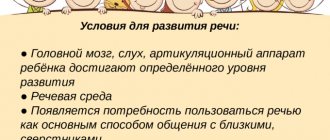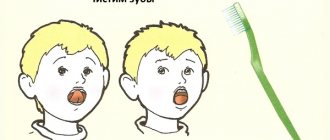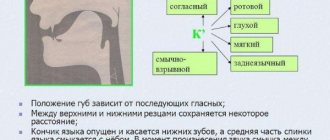Pronunciation of the T sound
We can highlight common mistakes made in the pronunciation of the T sound:
- replacing the sound T (it is front-lingual) with G and K (they are called back-lingual);
- mixing or rearranging consonants located next to the sound T (“rolled” instead of “glass”);
- after P or K, the T sound is lost and replaced with a softening (“piichka” instead of “birdie”);
- replacing the sounds Ch and C with T (“nine” instead of “girl”, “Petsya” instead of “Petya”).
Children who replace the T sound with some other sound often have incorrect articulation. The child raises his tongue to the palate, while the tip of the tongue should rest against the front teeth.
The reasons for incorrect pronunciation are as follows:
- malfunctions of the articulatory apparatus (speech organs);
- the lower jaw is weakly developed, which is why it is inactive during speech;
- the hearing organs are poorly developed, which is why the child cannot distinguish sounds by ear;
- imitating an adult who has problems with correct pronunciation.
Only a speech therapist can make a diagnosis. And parents, in turn, can practice at home the exercises recommended by a professional.
History of the letter D
The Church Slavonic name for this letter is “good”.
The appearance of the letter D is borrowed from a Greek letter called delta, which looks like a triangle. Only the printed Greek version has no legs.
But in the letter the paws are drawn.
Some people wonder why the printed letter D has two legs, but only one tail is written down on the letter.
This happened somewhere in the 14th-17th centuries. Then the formation of cursive writing began in the Russian language. And the letters of the alphabet began to lose some of their graceful elements.
This happened with lowercase D. It became slightly rounded, its curls fell off, and instead a tail-loop grew from below.
It is interesting that in the manuscripts of that time, when the formation of the written letter D was just being improved, two tails were observed at once: above and below. But drawing such a miracle was not in the rules of cursive writing, so they decided to cut off the upper tail once and for all.
So the letter acquired the form to which we are accustomed now.
And in the 18th century, Peter the Great, the letter D with one tail at the bottom was officially approved. The reason for this decision was that the two lower legs of the letter D seemed to remain, they were simply connected into a loop.
The option with an upper ponytail also remained in use. They began to choose: either the lower ponytail or the upper one.
It was the writing of the letter D with an upper loop tail that was popular among highly educated people. Leo Tolstoy wrote the letter D with an upper loop.
Ordinary people quickly switched to D with a lower loop.
The letter B occupies the second place of honor in the Russian alphabet. In the Glagolitic alphabet it corresponds to the numerical value 2.
In the Church and Old Church Slavonic alphabet it is called “buki” or “buki”, which translated means “letter”.
The letter D is the fifth from the beginning, twenty-ninth from the end of the alphabet and refers to paired voiced consonants. Its pair sound [T] is a voiceless consonant.
At the beginning of a word and in the middle, the letter D sounds loud, and at the end of the word it is deafened, so that its paired sound T is already heard.
Example: tree - bucket - vegetable garden. In the last word we hear T instead of D.
In the Church and Old Slavonic alphabet it is called “Good”.
She came to the Cyrillic alphabet from Byzantium, where her friend “delta” was written “paws down”, like the modern letter D.
Articulatory gymnastics for the sound t
It is necessary to do articulation exercises daily. Get used to the fact that in any free time you and your baby develop the speech apparatus.
More on the topic:
- Articulatory gymnastics for the sound Ш
- Exercises for sounds “S, C, Z”
Setting the T sound
- Choose several syllables or words that contain the letter combination TA, and repeat them at least 10 times.
- Place the tongue between the teeth and press it firmly, but at the same time so that it does not hurt the baby, with the jaw. Take a deep breath and, as you exhale, say an interdental T.
- Place your tongue between your teeth again. Stretch your teeth in a smile and “spit.” After this, give your jaw a rest.
- T is a derivative sound from P. Therefore, you can start warming up by practicing the sound P. Say Pa-Pa several times, while the wide part of the tongue should be pressed to the lower lip. Gradually stretch your lips into a smile and move on to pronouncing Ta-Ta.
- Place the tongue between the teeth. Say Pa-Pa again several times. At this moment, the adult spreads the child’s lips with his index finger and thumb. When the manipulation is performed correctly, Ta-Ta is pronounced.
How to teach a child to speak the sound [r] without a speech therapist at home
Sound production
- Talk to the child Ta-Ta.
- A special paddle is used to soften the sound. Use it to press the tip of your tongue and lower it down. You should get the letter combination Tya.
- The sound Th is produced by clicking the tip of the tongue; the teeth should be closed at this time.
- You can complicate the exercise: do not press your tongue against the palate, but stick it out.
Automation and differentiation of sound [T]
After the child has been able to correctly pronounce [T], it is necessary to move on to automating it - reinforcing the correct pronunciation. Automation should begin with the development of phonemic hearing - the perception of phonemes by ear. The child is asked to isolate a sound from a number of phonemes that are similar in acoustic-articulatory characteristics; isolate it from a series of syllables; isolate a sound from a series of words; determine its presence and location in a word. At the beginning of automation and with an insufficient level of speech development, it is necessary to start with sounds that are distant in acoustic-articulatory characteristics.
Then they move on to automating the phoneme in isolated form. It is practiced with a sharp exhalation using onomatopoeic games.
Then you need to introduce the child to the letter that represents the sound [T] in the letter. Explain how a sound differs from a letter: a sound is heard and spoken, but a letter is seen, written and read. They select objects from the surrounding world that look like the letter T.
If necessary, the correct spelling of the letter is practiced. A variety of graphic exercises are used, aimed at developing hand motor skills and training in obtaining an adequate image of a letter. When a child speaks the sound [T] well in isolation, the automation of phonemes in syllables, in words, in sentences, in coherent speech begins.
After automating the sound, they move on to its differentiation - distinguishing it from other sounds. It is carried out by analogy with automation: in isolation, in syllables, words, sentences, coherent speech. First, sounds that are distant in acoustic-articulatory characteristics are differentiated, ending with phonemes that have similar sound and articulation. The production of the sound [T] is considered complete if the child always pronounces [T] accurately, including in spontaneous speech.
Speech therapy exercises
It is necessary to work on overall articulation and clarity of speech. For this, simple and interesting speech therapy complexes are used. We present one of these to your attention.
- “Brushing our teeth.” Stretch your lips in a smile, mouth slightly open. Use your tongue to walk alternately over the upper and lower teeth from the back side. Move from left to right and then in the opposite direction.
- "Spatula". Smile again with your mouth slightly open. Place the wide part of your tongue on your lower lip. Stay in this position for 10 seconds. You can start with 5 seconds.
- “Tube”. Extend your tongue as much as possible and tense it. Then, if possible, roll it up into a tube and stay in this position for 5-10 seconds.
- "Swing". Open your mouth slightly and press the wide part of your tongue against your lower teeth. Then raise your tongue to your upper teeth. We linger in each position for 2-3 seconds. In this case, you need to press with maximum force.
- "Slide". Starting position – mouth slightly open. Press the tip of your tongue firmly against the bottom row of teeth. Then, without lifting the tip, press with the wide part of your tongue (it should bend as if). Stay in this position for 5 seconds.
- "Mountain Wind" Place your tongue in the position described in the previous exercise and blow as hard as possible. In this case, the entire speech apparatus should be tense.
Correct articulation of the sound D
- Lips in a neutral position, completely relaxed. The gap between the incisors and lips is approximately 4-5 mm. Depending on the vowel following D, the placement can be adjusted.
- The tip of the tongue rests on the upper part of the palate, touching the alveoli (these are small tubercles behind the upper row of front teeth).
- Lower the soft part of the palate.
- Cause vibration of the larynx.
- Close the vocal folds, add a little voice.
After working with articulation, we begin sound production. We start with preparatory classes, including articulation and breathing exercises.
Setting the sound t when replacing with k
- First you need to teach your baby to distinguish between these two sounds. To do this, you can give pictures, the images in which begin with the sounds T or K, and also pronounce such words out loud. Ask the child to distribute into groups (K and T).
- Game “Catch the Sound”. The adult pronounces a small series of letter combinations, and the child must clap his hands when he hears the given sound.
- We are looking for the sound K. Dar-ra-ko-so. Sa-lo-ku-we. Am-da-ka-he ku-ro-lo-ky
- We are looking for the sound T. Ba-ta-do. Na-la-to. Ash-bo-ot. Ju-fu-fu.
Plan for the final lesson on speech development in the middle group
Setting the t sound for dysarthria
At the very beginning, you need to pay attention to warming up the tongue and removing tone, as well as general gymnastics for the speech apparatus. For this purpose, the speech therapy exercises listed above are used.
- Raise and lower your tongue, turn right and left. In this case, the tongue is extended as much as possible.
- Then the adult invites the child to tap his tongue on the upper palate (the sound should be T).
- To obtain a soft consonant, the tongue is pressed harder against the palate and moves out more between the teeth. At the same time, the passage for air is reduced.
- To practice the T sound, it is pronounced between two vowels (at least 10 repetitions).
- The baby must cluck at least 20 times. After this, the task becomes more complicated: you need to click while exhaling, not while inhaling.
- The child is asked to place his palm on his larynx. After this, pronounce the sounds T and D. Focus on the difference in vibrations during the pronunciation of the sounds T and D.
How sound is produced
When pronouncing [T], the articulatory organs are in the following position: the lips stretch slightly, the teeth open, the tip of the tongue connects with the upper incisors, the air stream is sharp, breaks the bow, there is no voice.
In the initial position, the lips should open slightly, the gap between the dental rows is approximately 3-5 mm. The tip of the tongue hits the upper alveolar process, connecting with it. When playing [T], the soft palate rises, the vocal folds separate, and the air flow is jerky. The sound [T] is consonant, hard, occlusive, anterior lingual, explosive, noisy, deaf.










